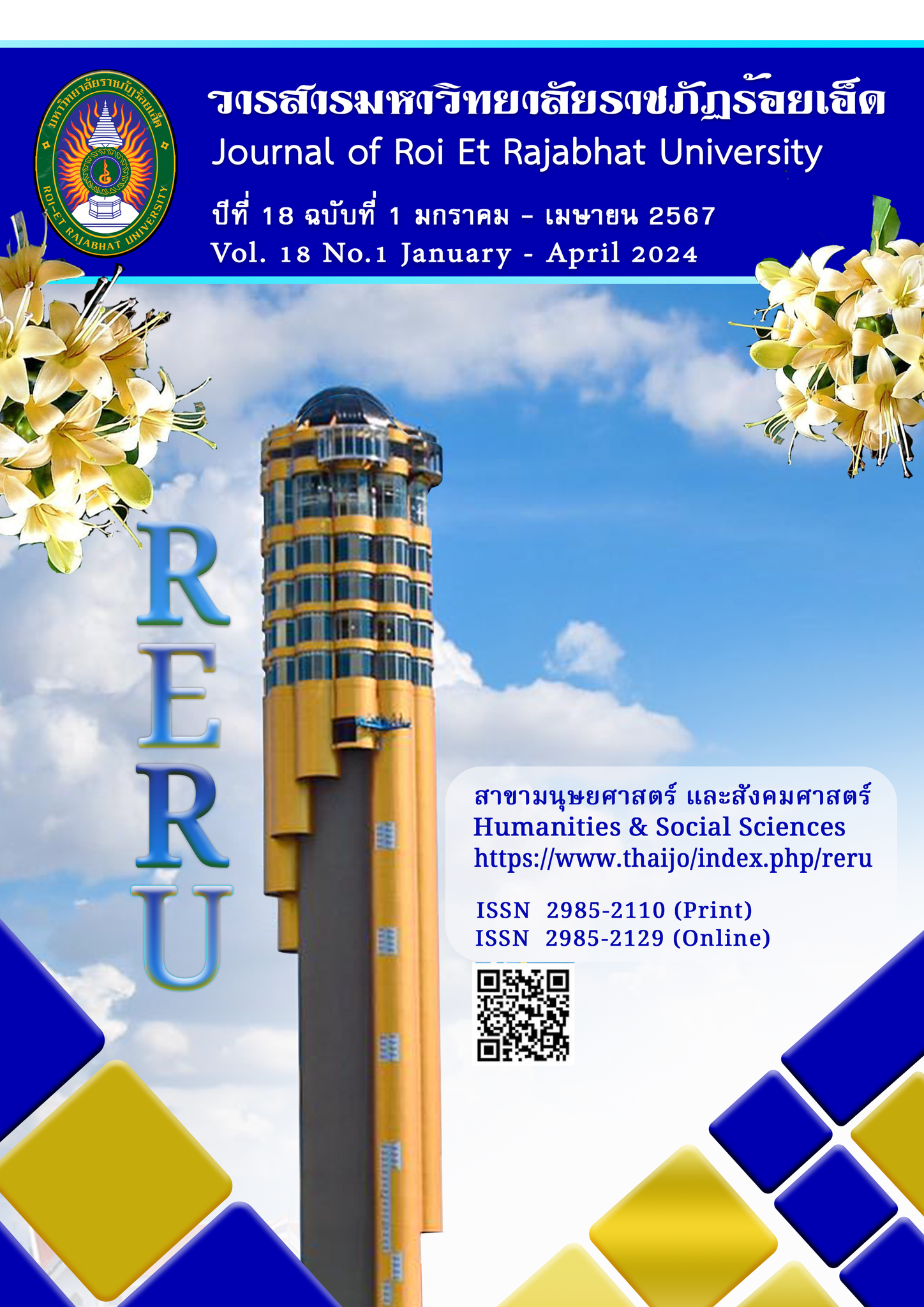Creative Leadership of School Administrators Affecting Teamwork of Teachers in School under Kalasin Primary Educational Service Area Office 1
Keywords:
Creative leadership, Teamwork of teachers, Kalasin Primary Educational Service Area Office 1Abstract
The purposes of this research were to: 1) study the creative leadership of school administrators under Kalasin Primary Educational Service Area Office 1; 2) study the teamwork of teachers under Kalasin Primary Educational Service Area Office 1; 3) study the relationship between creative leadership and teamwork of teachers under Kalasin Primary Educational Service Area Office 1, and 4) study the creative leadership of school administrators affecting teamwork of teachers. The samples were used of 322 people divided
into 27 school administrators and 295 teachers. The research instrument was used for data collection was a five-point rating scale questionnaire with the validity was 0.989 and the reliabilities of 2 variables were 0.986 and 0.970 respectively. The statistical methods employed in the data analysis were used frequency, percentage, mean, standard deviation, Pearson Product Moment Correlation Coefficient and Stepwise Multiple Regression analysis. The research findings were as follows; 1) The level of overall creative
leadership of school administrators was high. 2) The level of overall teamwork of teachers was high.
3) The relationship between the creative leadership of school administrators and teamwork of teachers,
in overall, was highly positive (rxy=.746) (p<.01). And 4) the creative leadership of school administrators included 5 aspects: creativity (X4), vision (X6), intellectual ability (X1), flexibility (X5) and positive attitude and personality (X3). These predictors could affect and predict 74.60% of teamwork of teachers with statistical significance at the .01 level. The prediction equations could be written as follow;
The regressive equation in the form of raw score:
Y/ = .563 + .200X4 + 0.199X6 + .142X1 + .179X5 + .147X3
The regressive equation in the form of standard score:
Z/y = .228ZX4 + .215ZX6 + .161ZX1 + .191ZX5 + .164ZX3
References
กิตติ์กาญจน์ ปฏิพันธ์. (2555). โมเดลสมการโครงสร้างภาวะผู้นำเชิงสร้างสรรค์ของผู้บริหารสถานศึกษาอาชีวศึกษา. ดุษฎีนิพนธ์
ปรัชญาดุษฎีบัณฑิต สาขาวิชาการบริหารการศึกษา. ขอนแก่น: มหาวิทยาลัยขอนแก่น.
เกศณี กฐินเทศ. (2562). ภาวะผู้นำเชิงสร้างสรรค์ของผู้บริหารสถานศึกษาสังกัดสำนักงานเขตพื้นที่การศึกษาประถมศึกษา
สุรินทร์ เขต 2. วิทยานิพนธ์ ครุศาสตรมหาบัณฑิต สาขาวิชาการบริหารการศึกษา. บุรีรัมย์: มหาวิทยาลัยราชภัฏ
บุรีรัมย์.
เกศสรินทร์ ตรีเดช. (2552). ภาวะผู้นำของผู้บริหารสถานศึกษาที่ส่งผลต่อการทำงานเป็นทีมของครูในโรงเรียนสังกัดสำนักงาน
เขตพื้นที่การศึกษามัธยมศึกษา เขต 26. วิทยานิพนธ์ ศึกษาศาสตรมหาบัณฑิต สาขาวิชาการบริหารการศึกษา.
ขอนแก่น: มหาวิทยาลัยขอนแก่น.
กรวิภา งามวุฒิวงศ์. (2559). ปัจจัยที่ส่งผลต่อการทำงานเป็นทีมภายในสำนักอำนวยการสำนักงานปลัดกระทรวงศึกษาธิการ.
วิทยานิพนธ์ รัฐศาสตรมหาบัณฑิต สาขาวิชาการบริหารรัฐกิจและกิจการสาธารณะ. กรุงเทพฯ: มหาวิทยาลัย
ธรรมศาสตร์.
กรองทิพย์ นาควิเชตร. (2552). ภาวะผู้นำสร้างสรรค์เพื่อการศึกษา. สมุทรปราการ: ธีรสาส์น พับลิชเชอร์.
เกรียงศักดิ์ เจริญวงศ์ศักดิ์. (2553). การคิดเชิงสร้างสรรค์. กรุงเทพฯ: ซัคเซสมีเดีย.
ทองทิพภา วิริยะพันธุ์. (2553). การบริหารทีมงานและการแก้ไขปัญหา (พิมพ์ครั้งที่ 4). กรุงเทพฯ: สหธรรมิก.
ทิศนา แขมมณี. (2550). การสอนจิตวิทยาการเรียนรู้ เรื่องศาสตร์การสอนองค์ความรู้เพื่อการจัดกระบวนการเรียนรู้
ที่มีประสิทธิภาพ (พิมพ์ครั้งที่ 5). กรุงเทพฯ: จุฬาลงกรณ์มหาวิทยาลัย.
เนตร์พัณณา ยาวิราช. (2556). การจัดการสมัยใหม่ (พิมพ์ครั้งที่ 8). กรุงเทพฯ: ทริปเพิ้ล.
บุญชม ศรีสะอาด. (2556). การวิจัยเบื้องต้น (พิมพ์ครั้งที่ 9). กรุงเทพฯ: สุวิริยาสาส์น.
ปิ่นทอง ศรีสวัสดิ์. (2560). การทำงานเป็นทีมของครูผู้สอน สังกัดสำนักงานเขตพื้นที่การศึกษามัธยมศึกษา เขต 17.
วิทยานิพนธ์ การศึกษามหาบัณฑิต สาขาวิชาการบริหารการศึกษา. ชลบุรี: มหาวิทยาลัยบูรพา.
ไพฑูรย์ สินลารัตน์. (2554). CCPR กรอบคิดใหม่ทางการศึกษา. กรุงเทพฯ: สำนักพิมพ์จุฬาลงกรณ์มหาวิทยาลัย.
ไพฑูรย์ สินลารัตน์ และนักรบ หมี้แสน. (2561). ความเป็นผู้นำทางการศึกษา (พิมพ์ครั้งที่ 3). กรุงเทพฯ: จุฬาลงกรณ์มหาวิทยาลัย.
วราภรณ์ ตระกูลสฤษดิ์. (2550). การทำงานเป็นทีม. กรุงเทพฯ: ศูนย์ส่งเสริมวิชาการ.
วิโรจน์ สารรัตนะ. (2557). ภาวะผู้นำ: ทฤษฎีและนานาทัศนะร่วมสมัยปัจจุบัน. กรุงเทพฯ: ทิพย์วิสุทธิ์.
วันเพ็ญ แก้วปาน. (2561). ภาวะผู้นำ: หลักการและการประยุกต์ในการพยาบาลเวชปฏิบัติชุมชน. กรุงเทพฯ: อรุณการพิมพ์.
ศรีศักดิ์ ศูนย์โศรก. (2550). การศึกษาพฤติกรรมการสร้างทีมงานของผู้บริหารโรงเรียนสังกัดสำนักงานเขตพื้นที่การศึกษาสระแก้ว
เขต 2. วิทยานิพนธ์ การศึกษามหาบัณฑิต สาขาวิชาการบริหารการศึกษา. ชลบุรี: มหาวิทยาลัยบูรพา.
สุพานี สฤษฏ์วานิช. (2552). พฤติกรรมองค์การสมัยใหม่: แนวคิดและทฤษฎี (พิมพ์ครั้งที่ 7). กรุงเทพฯ: มหาวิทยาลัย
ธรรมศาสตร์.
สุภาพ ฤทธิ์บำรุง. (2556). ภาวะผู้นำเชิงสร้างสรรค์ของผู้บริหารสถานศึกษาที่ส่งผลต่อความมีประสิทธิผลของโรงเรียน
สังกัดสำนักงานเขตพื้นที่การศึกษามัธยมศึกษา เขต 30. วิทยานิพนธ์ ศึกษาศาสตรมหาบัณฑิต สาขาวิชาบริหาร
การศึกษา. ขอนแก่น: มหาวิทยาลัยขอนแก่น.
สุเมธ งามกนก. (2550). การสร้างทีมงาน. วารสารศึกษาศาสตร์, 19(1), 31-44.
สำนักงานเขตพื้นที่การศึกษาประถมศึกษากาฬสินธุ์ เขต 1. (2564). รายงานผลการดำเนินงานประจำปี พ.ศ. 2564. สืบค้นเมื่อ
ธันวาคม 2564, จาก https://www.ksn1.go.th/web2020/?p=15947
Bennis, W. (2002). Creative Leadership. Bangkok: Chulalongkorn University.
Danner, S. E. (2008). Creative leadership in art education: Perspectives of an art educator. Thesis Master of
Arts, Art Education. Fine Art: Ohio University.
Delich. (2010). The Impact of Mercosur's Sanitary and Phytosanitary Regime on its Members' Institutional
Dynamics. Journal of CMA Management, 79(2), 3-3.
Dubrin, A. J. (2006). Leadership. (2nd ed.). Asia Pacific Edition. Boston: Houghton Mufflin Company.
Harding, T. (2010). Fostering Creativity for Leadership and Leading Change. Journal of Arts Education Policy
Review, 111(2), 51-53.
Harris, A. (2009). Creative leadership. Journal of Management in Education, 23(1), 9-11.
Parker, G. M. (1990). Team players and team work: The new competitive business strategy. San Francisco:
Jossey-Bass.
Parker, J.O. and Begnaud, L.G. (2004). Statistics: An introductory analysis (3rd ed.). New York: Harper & Row.
Puccio, G. J., Murdock, M. C., and Mance, M. (2007). Creative Leadership: Skills that Drive Change. California: Sage.
Robbins, S.P. (2001). Eessentails of Organization Behavior (8rd ed.). Englewood Chiffs: Prentice - Hall.
Robinson, K. (2007). The Principles of Creative Leadership. New York: McGraw-Hill.
Romig, D. (1996). Breakthrough Teamwork: Out Standing Result Using Structured Teamwork. Chicago: Irwin.
Sheard, A. G. and Kakabadse, A. P. (2004). A process perspective on leadership and team. Journal of
Management Development, 23(1), 7-106.
Stemberg, R. J. (2006). Creative Leadership: It's a Decision. Journal of Leadership, 36(2), 22-24.
Stoll, L. and Temperley, J. (2009). Creative leadership: a challenge of our times. London: University of
London.
Ubben, G. C., Hughes, L. W. and Norris, C.J. (2011). The Principal: Creative Leadership for Effective Schools.
Boston: Allyn & Bacon.
Woodcock, M. (1989). Team development manual. Worcester: Billing and Sons.
Downloads
Published
How to Cite
Issue
Section
License
Copyright (c) 2024 Roi Et Rajabhat University

This work is licensed under a Creative Commons Attribution-NonCommercial-NoDerivatives 4.0 International License.
บทความที่ได้รับการตีพิมพ์เป็นลิขสิทธิ์ของวารสารมหาวิทยาลัยราชภัฎร้อยเอ็ด
ข้อความที่ปรากฏในบทความแต่ละเรื่องในวารสารวิชาการเล่มนี้เป็นความคิดเห็นส่วนตัวของผู้เขียนแต่ละท่านไม่เกี่ยวข้องกับมหาวิทยาลัยราชภัฎร้อยเอ็ด และคณาจารย์ท่านอื่นๆในมหาวิทยาลัยฯ แต่อย่างใด ความรับผิดชอบองค์ประกอบทั้งหมดของบทความแต่ละเรื่องเป็นของผู้เขียนแต่ละท่าน หากมีความผิดพลาดใดๆ ผู้เขียนแต่ละท่านจะรับผิดชอบบทความของตนเองแต่ผู้เดียว





